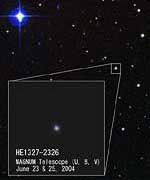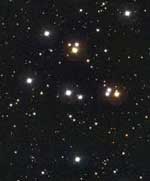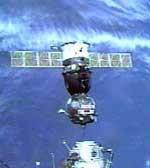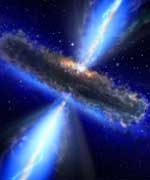A fundamental number that affects the color of light emitted by atoms as well as all chemical interactions has not changed in more than 7 billion years, according to observations by a team of astronomers charting the evolution of galaxies and the universe.
The results are being reported today (Monday, April 18) at the annual meeting of the American Physical Society (APS) by astronomer Jeffrey Newman, a Hubble Fellow at Lawrence Berkeley National Laboratory representing DEEP2, a collaboration led by the University of California, Berkeley, and UC Santa Cruz. Newman is presenting the data and an update on the DEEP2 project at a 1 p.m. EDT press conference at the Marriott Waterside Hotel in Tampa, Fla.
The fine structure constant, one of a handful of pure numbers that occupy a central role in physics, pops up in nearly all equations involving electricity and magnetism, including those describing the emission of electromagnetic waves – light – by atoms. Despite its fundamental nature, however, some theorists have suggested that it changes subtly as the universe ages, reflecting a change in the attraction between the atomic nucleus and the electrons buzzing around it.
Over the past few years, a group of Australian astronomers has reported that the constant has increased over the lifetime of the universe by about one part in 100,000, based on its measurements of the absorption of light from distant quasars as the light passes through galaxies closer to us. Other astronomers, however, have found no such change using the same technique.
The new observations by the DEEP2 survey team use a more direct method to provide an independent measure of the constant, and show no change within one part in 30,000.
“The fine structure constant sets the strength of the electromagnetic force, which affects how atoms hold together and the energy levels within an atom. At some level, it is helping set the scale of all ordinary matter made up of atoms,” Newman said. “This null result means theorists don’t need to find an explanation for why it would change so much.”
The fine structure constant, designated by the Greek letter alpha, is a ratio of other “constants” of nature that, in some theories, could change over cosmic time. Equal to the square of the charge of the electron divided by the speed of light times Planck’s constant, alpha would change, according to one recent theory, only if the speed of light changed over time. Some theories of dark energy or grand unification, in particular those that involve many extra dimensions beyond the four of space and time with which we are familiar, predict a gradual evolution of the fine structure constant, Newman said.
DEEP2 is a five-year survey of galaxies more than 7-to-8-billion-light years distant whose light has been stretched out or redshifted to nearly double its original wavelength by the expansion of the universe. Though the collaborative project, supported by the National Science Foundation, was not designed to look for variation in the fine structure constant, it became clear that a subset of the 40,000 galaxies so far observed would serve that purpose.
“In this gigantic survey, it turns out that a small fraction of the data seems to be perfect for answering the question Jeff’s asking,” said DEEP2 principal investigator Marc Davis, professor of astronomy and of physics at UC Berkeley. “This survey is really general purpose and will serve a million uses.”
Several years ago, astronomer John Bahcall of the Institute for Advanced Study pointed out that, in the search for variations in the fine structure constant, measuring emission lines from distant galaxies would be more direct and less error-prone that measuring absorption lines. Newman quickly realized that DEEP2 galaxies containing oxygen emission lines were perfectly suited to provide a precise measure of any change.
“When the contradictory results from absorption lines starting showing up, I had the idea that, since we have all these high redshift galaxies, maybe we can do something not with absorption lines, but with emission lines within our sample,” Newman said. “Emission lines would be very slightly different if the fine structure constant changed.”
The DEEP2 data allowed Newman and his colleagues to measure the wavelength of emission lines of ionized oxygen (OIII, that is, oxygen that has lost two electrons) to a precision of better than 0.01 Angstroms out of 5,000 Angstroms. An Angstrom, about the width of a hydrogen atom, is equivalent to 10 nanometers.
“This is a precision surpassed only by people trying to look for planets,” he said, referring to detection of faint wobbles in stars due to planets tugging on the star.
The DEEP2 team compared the wavelengths of two OIII emission lines for 300 individual galaxies at various distances or redshifts, ranging from a redshift of about 0.4 (approximately 4 billion years ago) to 0.8 (about 7 billion years ago). The measured fine structure constant was no different from today’s value, which is approximately 1/137. There also was no upward or downward trend in the value of alpha over this 4-billion-year time period.
“Our null result is not the most precise measurement, but another method (looking at absorption lines) that gives more precise results involves systematic errors that cause different people using the method to come up with different results,” Newman said.
Newman also announced at the APS meeting the public release of the first season of data (2002) from the DEEP2 survey, which represents 10 percent of the 50,000 distant galaxies the team hopes to survey. DEEP2 uses the DEIMOS spectrograph on the Keck II telescope in Hawaii to record redshift, brightness and color spectrum of these distant galaxies, primarily to compare galaxy clustering then versus now. The survey, now more than 80 percent complete, should finish observations this summer, with full data release by 2007.
“This is really a unique data set for constraining both how galaxies have evolved and how the universe has evolved over time,” Newman said. “The Sloan Digital Sky Survey is making measurements out to about redshift 0.2, looking back the last 2-3 billion years. We really start at redshift 0.7 and peak at 0.8 or 0.9, equivalent to 7-8 billion years ago, a time when the universe was half as old as it is today.”
The survey also has completed measurements that could shed light on the nature of dark energy – a mysterious energy that permeates the universe and seems to be causing the universe’s expansion to accelerate. The team now is modeling various theories of dark energy to compare theoretical predictions with the new DEEP2 measurements.
As Davis explained it, the amount of dark energy, now estimated to be 70 percent of all the energy in the universe, determines the evolution of galaxies and clusters of galaxies. By counting the number of small groups and massive clusters of galaxies in a distant volume of space as a function of their redshift and mass, it is possible to measure the amount by which the universe has expanded to the present day, which depends on the nature of dark energy.
“Basically, you count the clusters and ask, ‘Are there a lot, or a few?'” Davis said. “That’s all it amounts to. If there are very few clusters, that means the universe expanded quite a ways. And if there are a lot of clusters the universe didn’t expand as much.”
Davis currently is comparing DEEP2 measurements with predictions of the simplest dark energy theory, but hopes to collaborate with other theoreticians to test more exotic dark energy theories.
“What they are really trying to get at is how the dark energy density is changing as the universe is expanding,” said UC Berkeley theoretical physicist Martin White, a professor of astronomy and of physics who has worked with Davis. “If the dark energy density is Einstein’s cosmological constant, then the theoretical prediction is that it doesn’t change. The holy grail now is to get some evidence that it’s not the cosmological constant, that it is in fact changing.”
Original Source: UC Berkeley




